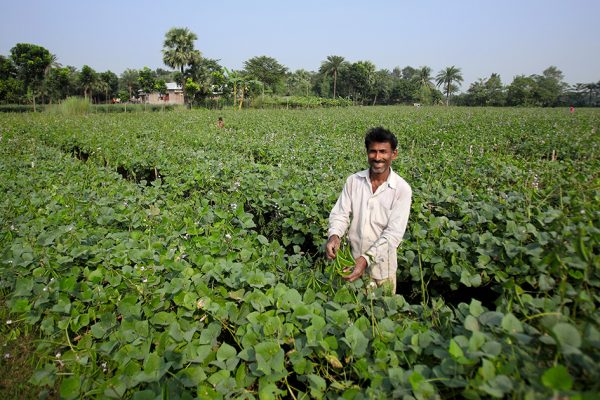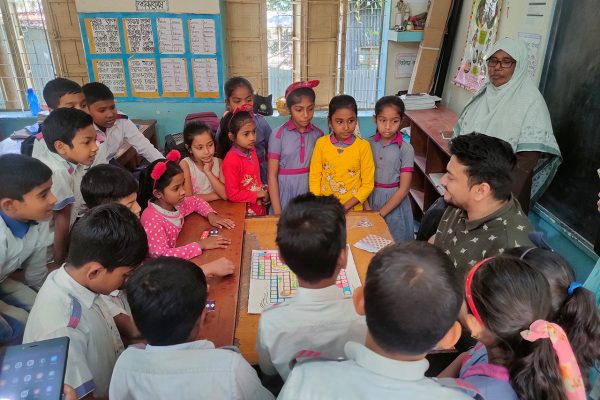The safe space intervention
Reading Time: 3 minutes
Around 20 girls sit in a small room, decorated with messages about leadership, reproductive health and family planning along with pictures they have drawn themselves. This is a BRAC Empowerment and Livelihood for Adolescents (ELA) club. This particular club called Bwebajja is located in a semi-urban area, under BRAC’s Kajjansi branch in Uganda. Huddled together, the girls look up at us, muzungus (foreigners) with awe and anticipation. They know who we are. They know BRAC. They call it “Blaca.”
Around 20 girls sit in a small room, decorated with messages about leadership, reproductive health and family planning along with pictures they have drawn themselves. This is a BRAC Empowerment and Livelihood for Adolescents (ELA) club. This particular club called Bwebajja is located in a semi-urban area, under BRAC’s Kajjansi branch in Uganda. Huddled together, the girls look up at us, muzungus (foreigners) with awe and anticipation. They know who we are. They know BRAC. They call it “Blaca.”
These girls are between 13 to 24 years of age. Most of them are out of school and had it not been for BRAC, they would have fallen victim to dire situations. Many of them are dropouts who left school at Senior 4 (Uganda’s equivalent to O-Level year). Three of them gave birth when they were practically children themselves.
There was one school-going girl at the club at that day. She was younger than the rest. She said other school-going girls come too, but mostly during the summer. In Uganda, the majority of schools are boarding schools, thus most school-going members attend only during their summer vacation.
We asked them what they did at the clubs and they spoke of activities like reading books, and indoor games. BRAC’s ELA programmes are designed to empower teenage girls, allowing them to socialise and flourish through mentoring and life skills training. Operating in four other countries besides Uganda, these clubs are their safe spaces, where girls can sing, dance, and perform dramas. They can ask questions and not be afraid of the consequences. They also play several outdoor games such as netball and handball to stay physically healthy.
ELA club members also learn about 10 topics as part of their life skills-based education (LSBE), including adolescent sexual and reproductive health, menstruation and menstrual disorders, leadership among adolescents, gender and bride price, early pregnancy, sexually transmitted infections, HIV/AIDs awareness, family planning, rape, and adolescent responsibility toward family and community. They receive this training once a week for a total of 20 sessions, and it is led by the club mentors, who have received training from BRAC.
The girls at the Bwebajja club said they most often discussed family planning, early pregnancy, and rape. They acted out a drama in which they combined the issues to depict their effects. The plot was that a girl, while taking a walk down the street, starts to get harassed by a man on drugs and he rapes her. She ends up being pregnant and when she goes and asks for her mother’s support her mother blames her for walking alone at night. She then goes to a friend who takes her to a mentor of the ELA club who guides her on the next steps and tells her she can find a support system at ELA clubs.
On asking them what they understood about family planning the girls mentioned child spacing, methods of family planning and the advantages of delaying childbirth. They answered that the ideal age to have one’s first child should be at least 20. I could tell they had internalised the issues of teenage pregnancy and rape and ELA’s influence was visible.
In an impact evaluation study from 2012, it was found that 67 per cent of ELA club participants were using condoms regularly as opposed to 38 per cent in non-intervention villages. But this is not only a result of simply disseminating messages through LSBE; there are other components such as the financial literacy training, the livelihood training, and microfinance to help girls become financially and socially empowered. This integrated approach ensures that their comprehensive set of needs is being addressed.
The study quoted above has also shown the ELA programme to have a significant impact on economic empowerment of the girls in regards to their engagement in income-generating activities, personal income, financial literacy, entrepreneurial ability, financial market participation, and personal savings. Results indicating a substantial increase in entrepreneurial self-employment activities are encouraging in comparison to analyses of other programmes with stand-alone entrepreneurship training that have found limited positive impacts.
A lot of the girls at the clubs talked about having their own businesses. “When I have set aside enough money to pay for my school fees, I will go back to school,” one of the girls, Rahama, proudly declared. Some of the girls had boutiques; others sold soft drinks, and a few sold cosmetics. Each girl in the club had a different story, a story of resilience, a story of survival. Each had their own struggle and each supported the other in their endeavours to be empowered.
In a country where lack of resources and poverty remain major concerns, and the youth accounts for 78 per cent of the total, freedom from their struggles is still a distant dream. However, BRAC’s ELA programme is a much needed intervention and it was clear that at least the girls of the Bwebajja club are on the right track.
Shagufe Hossain is a programme officer at BRAC International.






